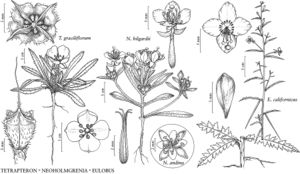Tetrapteron graciliflorum
Syst. Bot. Monogr. 83: 214. 2007.
Herbs densely pilose. Stems rarely with ascending lateral branches to 2.5 cm. Leaves: blade linear to very narrowly lanceolate, 1–9.8 ×0.1–0.9 cm, dilated at base, margins entire or very sparsely serrulate. Flowers opening near sunrise; floral-tube 1.6–3.2 mm; sepals 4.5–8 mm; petals 5–18 mm; episepalous filaments 1.8–3.2 mm, epipetalous filaments 0.8–1.6 mm; sterile projection of ovary 6–45 mm; style 3–5.5 mm, short-hairy near base; stigma 1–1.6 mm diam., surrounded by anthers of longer stamens at anthesis. Capsules irregularly obovoid, sharply 4-angled, thick-walled, somewhat woody, with pointed wing near center-top of each valve, 4–8 × 2.6–4.8 mm, tardily dehiscent in distal 1/3. Seeds tan with dark splotches, obovoid, 1.2–2 mm. 2n = 14.
Phenology: Flowering Mar–May.
Habitat: Colonial on open or brushy slopes, on clay soil, grasslands, Yucca or juniper and oak shrublands.
Elevation: 0–800 m.
Distribution
Calif., Oreg., Mexico (Baja California)
Discussion
Tetrapteron graciliflorum is rare in Oregon, known only from a few collections in Jackson and Josephine counties. In Baja California, Mexico, it is known only from Rancho Aguajito.
Selected References
None.
